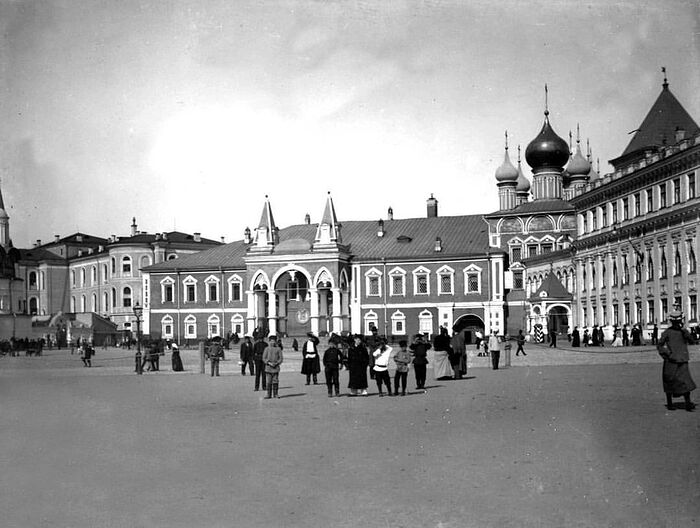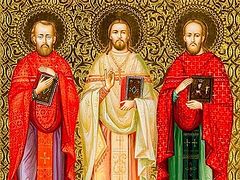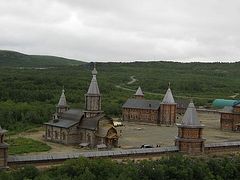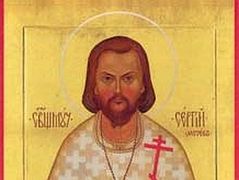Such a brilliant, fiery preacher and chanter of the Divine Liturgy as the bishop of Dimitrov, St. Seraphim (Zvezdinsky), Moscow never saw. It is not without reason that people called him the “Moscow Argyrostom” (Silver-tongued). But his main sermon was his life, which was a complete example of patient, unmurmuring, martyric cross-bearing.
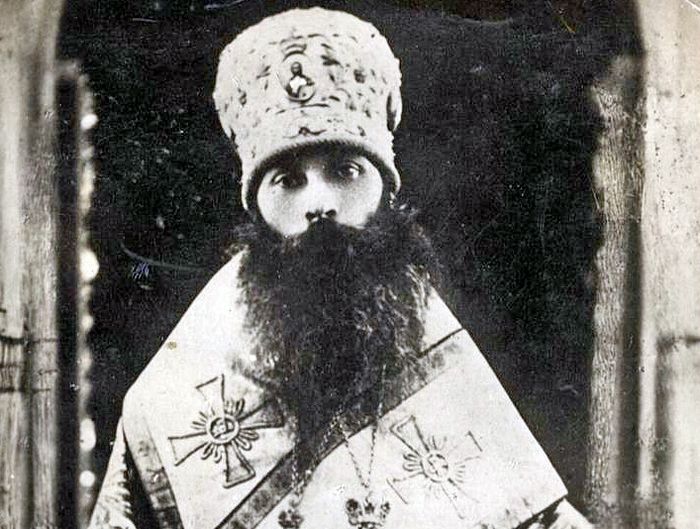 Holy Hieromartry Seraphim (Zvezdinsky)
Holy Hieromartry Seraphim (Zvezdinsky)
From the Bonifatievs to the Zvezdinskies
St. Seraphim’s father, Ioann Gavrilovich, belonged to the famous Bonifatiev line of Old Believers, relentless warriors for the Rule. It was Ioann Gavrilovich’s destiny to take the decisive step towards the Orthodox Church: He recieved the Edinoverie, or United Faith,[1] along with the new surname Zvezdinsky. His father cursed him to the third generation for this.
Later, when he married the daughter of a Edinoverie priest, Ioann Gavrilovich became a priest himself and began serving in the city of Rzhev. In the 1880s he was already the rector of the Holy Trinity-Presentation Church in Moscow. His authority was so great that many of the Old Believers who came to him converted to Edinoverie. Soon Fr. Ioann was appointed dean of all the Edinoverie churches of Moscow.
Nicholai’s childhood
It was Great Lent. On April 7, 1883, a boy was born to the Zvezdinsky family. This happened on a Thursday, and that is probably why the boy was named Nicholai. Later this boy would also become a holy hierarch—Bishop Seraphim (Zvezdinsky).
When Kolya (Nicholai) was around three years old, his mother died during childbirth. His sister who survived the birth did not live long—only six years. Left to Nicholai were his father, his elder brother Mikhail, and elder sister Anna. After the death of his wife, his father was invited to receive the monastic tonsure so that he could become a bishop, but he declined because of his children. Their primary education came from their nanny.
There was one known event that is quite interesting. Once when he was just a little boy, Nicholai entered into the church by himself and walked right through the royal doors [into the altar]. Witnesses to this event saw a sign in this that the boy would also become a priest.
At seven years of age, kidney stones were discovered in the boy, and he ended up in the hospital. His kidney stones passed, through his father’s prayers.
Spiritual education
Nicholai received his elementary education in the parish school at the Edinoverie church. After school he entered the Zaikonospassky institute. During that time, the court iconographer Guryanov often visited the Zvezdinsky home. He told them much about the royal court and jokingly invited Kolya to come to the court with him. The boy took an interest, and wondered what his function would be there. “A royal page”, replied the artist. To serve the Tsaritsa herself!.. Nicholai was enraptured by the thought. Later the bishop would remember this story: “So, the Lord really did call me to serve the Tsaritsa of all tsaritsas, the Heavenly Queen, and not the earthly.”
After the institute came the Moscow Theological Seminary, which Nicholai entered in 1899. There he gave his first sermon. During that same time he was ordained as a reader and subdeacon by Bishop Parfeny (Levitsky). The ordination took place in the Christ the Savior Cathedral.
An unusual healing
In his third year of seminary, Nicholai Zvezdinsky unexpectedly fell sick with lymphadenitis (inflammation of the lymph nodes). This illness was considered incurable in those days, and surgery could prove fatal. It was then that Nicholai’s father visited the abbot of Sarov Monastery, Fr. Ierofei (Melentiev). He gave Fr. Ioann an iconographic image of Seraphim of Sarov, who had not yet been glorified among the saints, and Fr. Ioann gave it to Kolya. Before going to sleep Nicholai pressed the small icon to his ailing side, and in the morning those of his household became witnesses of an amazing miracle—the abscess broke by itself. Gradually Nicholai began to recover. This miracle of healing was documented by well-known doctors, and testimony was sent to Sarov Monastery.
Soon Fr. Ioann was able to express his gratitude to Seraphim of Sarov by composing a service to the him, which the Holy Synod had assigned him to do for the saint’s canonization. The pastor himself participated in the glorification solemnities that took place in Sarov in 1903. For the composition of the service to the newly-canonized saint, he was awarded by the Sovereign a pectoral cross with diamonds, and an icon with a gift signature.
There exists testimony that after the opening of the reliquary, Fr. Ioann himself saw St. Seraphim “in person”. Deeply affected by this miracle, he did not leave detailed recollections of what apparently cannot be expressed in words.
The Moscow Theological Academy, and the tonsure
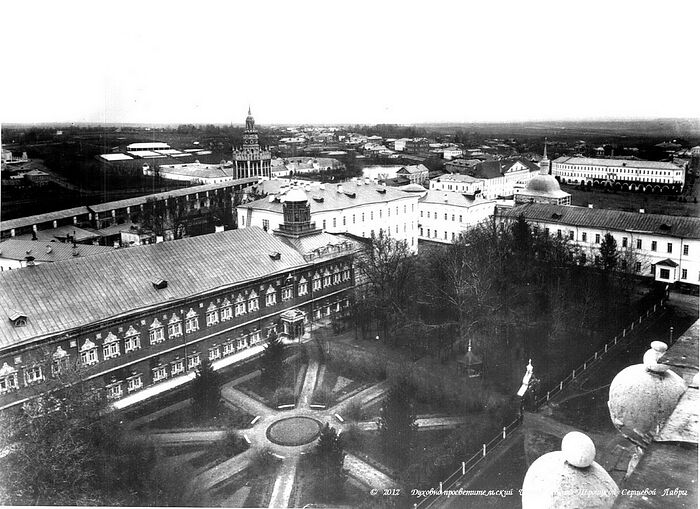 The Moscow Theological Academy in the Holy Trinity-St. Sergius Lavra
The Moscow Theological Academy in the Holy Trinity-St. Sergius Lavra
While still studying in the seminary, Nicholai Zvezdinsky was called to military service, but he received a “white ticket” and was released from service. After completing seminary as one of its best students, he was sent to study at the Moscow Theological Academy. He was already famous even in that period for his sermons, which he delivered in the Academy church. The rector of the Academy, Archimandrite Evdokim (Meshchersky), was well disposed towards the young student. He appointed him as church warden, entrusting the church cash box to him; and when Evdokim became a bishop he made him is subdeacon.
An important event for Nicholai was his visit to the St. Zosima Hermitage, where he met Elder Alexei (Soloviev), who then took him under his spiritual “wing”. During that time, Nicholai’s decision concerning monasticism was ripening. Together with two of his comrades he gave a vow at the reliquary of St. Sergius to receive the monastic tonsure. Fr. Alexei blessed him for this…
In 1907, on the feast of the Baptism of the Lord, Nicholai’s father reposed in the Lord. The parish community persistently requested that Nicholas be appointed their rector, but foreseeing a higher calling for the young man, the bishop refused.
Around that time, the first of Nicholai’s comrades who had given their vow before St. Sergius’s relics was already tonsured. The second, who had changed his mind, died just before his wedding. Now Nicholai was next to submit his request for tonsure. As soon as he made that decision, a whole storm broke out around him and in his soul. Everyone tried to divert him from this path, and to change all his plans.
Nicholai nevertheless did not back down, and overcoming all the temptations, submitted his request. But for all that, immediately after his tonsure, which took place on September 26, 1907, as he himself recalls he received extraordinary spiritual consolation. He was also gladdened by the name he received at the tonsure: St. Seraphim of Sarov, whom he so loved.
On November 4, 1908, Fr. Seraphim was ordained a hierodeacon by the Academy dean. On July 21 of the following year, he became a hieromonk. Notably, both ordinations took place on the feast of the Kazan icon of the Mother of God.
As a teacher
In 1909, Fr. Seraphim graduated from the Academy as a Theology candidate. He was immediately appointed as a history teacher in the Bethany Seminary, near Moscow. The students greatly loved their teacher. He himself admitted that he prayed for each one of them at the proskemidia [at which particles are removed for each name before the Liturgy].
In September 1912, Hieromonk Seraphim was transferred to the Moscow Seminary. There he taught homiletics and other disciplines connected with it.
The “Moscow “Argyrostom”
While still studying at the Academy, Fr. Seraphim became a frequent guest at the Chudov Monastery.[2] There he became friends with the monastery’s abbot, Archimandrite Arseny (Zhadanovsky). In the spring of 1912, they made a pilgrimage together to Jerusalem.
When in 1914 Archimandrite Arseny was consecrated bishop of Serpukhov, Fr. Seraphim was appointed abbot of the monastery. On June 10 he was elevated to the rank of archimandrite. Thus did words of Elder Gerasim (Antsiferov) come true; at his first meeting with Hieromonk Seraphim the elder called him an archimandrite,and abbot of Chudov Monastery.
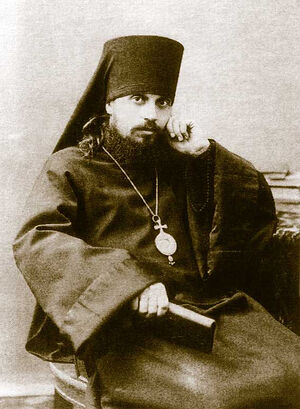 Bishop Arseny (Zhadanovsky) Very soon, Archimandrite Seraphim became well known thanks to his remarkable sermons, for which the people called him the “Moscow Argyrostom”. But Vladyka Arseny called him “Gentle Light”, apparently for his quiet and meek manner.
Bishop Arseny (Zhadanovsky) Very soon, Archimandrite Seraphim became well known thanks to his remarkable sermons, for which the people called him the “Moscow Argyrostom”. But Vladyka Arseny called him “Gentle Light”, apparently for his quiet and meek manner.
During the October 1917 Bolshevik storm on the Kremlin, Archimandrite Seraphim and Bishop Arseny were in the Chudov Monastery. At one moment Fr. Seraphim saw St. Seraphim of Sarov enter the abbot’s cell, where the archimandrite was hiding. In the end that cell remained intact, and no one was harmed.
On July 26, Bishop Arseny and Archimandrite Seraphim were forced to leave Chudov Monastery, but they were not allowed to take the holy relics out of it. After living for a while in the St. Zosima Hermitage, in August 1918 they moved to the St. Seraphim Skete of the Sign, where the abbess was Schema-Abbess Famar (Mardzhanova)—the spiritual daughter of Bishop Arseny. There they built a unified coenobium not far from the skete, where they lived for a year and a half.
Bishop of Dimitrov
In 1919, His Holiness Patriarch Tikhon summoned Archimandrite Seraphim to Moscow. He expressed his wish to see Fr. Seraphim as Bishop of Arzamas [near Sarov]. The consecration took place on January 3, 1920. But the Bolshevik authorities would not allow Vladyka Seraphim to enter Arzamas. His Holiness the Patriarch saw God’s Providence in this and kept him close to himself, appointing him vicar bishop, his cathedra in the city of Dimitrov.
On January 25, 1921, Vladyka Seraphim arrived at the St. Nicholas-Peshnosha Monastery. The Blachernae Monastery of the Savior also came under his spiritual care. Vladyka often served in the Kazan Church in the village of Podlipichye, across from which he lived.
Very quickly Bishop Seraphim was able to win authority among the flock entrusted to him. But soon harassments began against the very active bishop.
It was the year 1922, and there was a terrible famine in the country… Under the pretext of helping the hungry, the authorities began their campaign of confiscating church valuables. On May 6, 1922, His Holiness Patriarch Tikhon was put under house arrest.
In June of 1922, the confiscation of church valuables went on in the Peshnosha Monastery, after which the monastery was closed. The monastery brethren formed an agricultural team, which nonetheless did not last long. The Blachernae Monastery suffered the same fate.
First arrest and exile
On December 10, 1922 Vladyka served the last Liturgy, after which he was summoned to the Lubyanka.[3] On December 12 he was arrested—he was accused of protesting against the confiscation of church valuables. Vladyka was transferred to Butyrsky prison. He began having heart attacks, and his health quickly deteriorated. Bishop Seraphim was temporarily transferred to a semi-hospital regime, but when they saw that he prayed before the icons they returned him again to the common prison cell.
His accusation was officially articulated only on March 22, 1923. His punishment was exile to Zyryan province for three years. On May 13, 1923, Bishop Seraphim was taken under prison escort from Tagansky prison to Ust-Sisolsk. He was accompanied by Bishop Afanassy (Sakharov) of Kovrov, and others of like mind with them.
On June 7, Vladyka was sent to the town of Vizinga. Vladyka called his time in Kolyol[4] “saving exile”. In his cell he put together a church in honor of the “Quick to Hear” icon of the Mother of God, and completed the services daily. Vladyka kept up a correspondence with the flock in Dimitrov, who always supported him and sent him packages.
A bishop without a cathedra
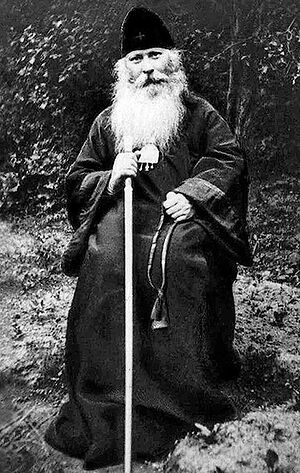 St. Seraphim Vladyka’s first exile ended in 1925. In the same year, His Holiness Patriarch Tikhon died. The bishop was summoned to Dimitrov. But upon his arrival he was summoned to the Lybyanka, where he was told that it was a mistake. He was forced to move to Danilov Monastery, from which he had to go to the Lubyanka every day for two months. No new accusations were brought against him, but they would not permit the bishop to return to his cathedral in Dimitrov.
St. Seraphim Vladyka’s first exile ended in 1925. In the same year, His Holiness Patriarch Tikhon died. The bishop was summoned to Dimitrov. But upon his arrival he was summoned to the Lybyanka, where he was told that it was a mistake. He was forced to move to Danilov Monastery, from which he had to go to the Lubyanka every day for two months. No new accusations were brought against him, but they would not permit the bishop to return to his cathedral in Dimitrov.
In July 1925, Bishop Seraphim came to Anosina Hermitage.[5] He didn’t stay there long, because in September of the same year he was summoned by Metropolitan Peter (Polyansky), the Locum Tenens of the Patriarchal throne, to Moscow. He appointed Vladyka Seraphim as his assistant. Vladyka took up his responsibilities, and received the clergy every day.
On December 9, 1925, Metropolitan Peter was arrested. Not long before his arrest he was able to appoint the bishop as chairman of the Council of Moscow Vicar Bishops, so that he could govern the Moscow dioceses. However on December 10, 1925, he was removed from this position by Metropolitan Sergius (Starogorodsky), who temporarily oversaw the Moscow and Kolomna dioceses, and another candidate was appointed to this position.
Vladyka returned to Anosino Monastery. In the winter he moved to the skete, and lived in a homestead near Kubinka. As he did everywhere he wound up, Bishop Seraphim served the full cycle of services every day according to the rubrics.
At that time his illness became acute (before this Vladyka was found to have kidney stones and a liver disease). On February 25, 1926, he had a strong attack and it was thought he wouldn’t survive. But someone saw Holy Hierarch Alexiy (of Moscow) enter the altar of the church, where they discovered that the lampada was burning. After serving a moleben to St. Alexiy, Vladyka began to get well. Under the pretext of his illness the authorities tried to force him to step down from the Dimitrov cathedra, but Bishop Seraphim refused to do so.
Diveyevo Convent
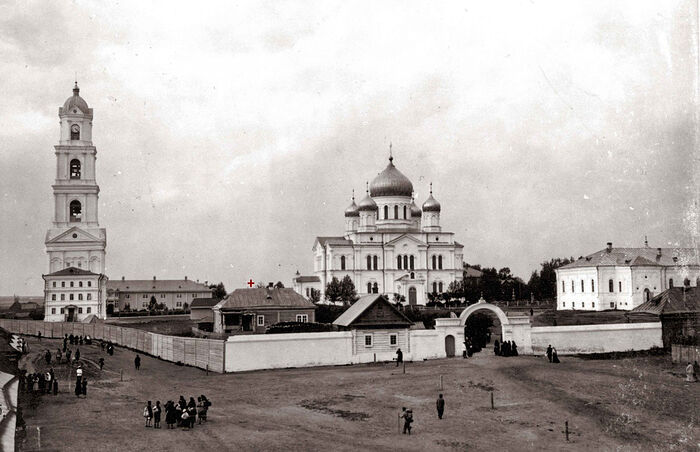 Panorama of Diveyevo Convent. Photo, early 20th c.
Panorama of Diveyevo Convent. Photo, early 20th c.
A new summons to the Lybyanka was issued on July 12, 1926. Vladyka was ordered to leave Moscow for Novgorod; however, he managed to get consent to go instead of to Novgorod, to Diveyevo, where he arrived on July 18, 1926.
The abbess received Bishop Seraphim coldly. Bishop Zinoviy (Drozdov was already living in the monastery. At first the bishop of Dimitrov was not even allowed to serve. Later the basement church of the “Assuage my Sorrow” Icon was cleared out for him. He began to serve the Liturgy every day, every day he prayed along the Holy Canal, and often prayed in the forest.
In 1926 he was still able to go to Sarov, and served there twice at the festal services—on the day of the canonization of St. Seraphim of Sarov, and on the Dormition. But immediately afterwards, Vladyka was forbidden to leave Diveyevo.
Many of the Diveyevo sisters were convinced that Elder Seraphim’s prophecy concerning the Canal, over which the antichrist will not trespass, would come to pass in the literal sense, and therefore they had no fear of the Bolsheviks coming into the monastery. But Vladyka Seraphim was convinced that they did not understand this prophecy correctly, that it needed to be understood spiritually. “You don’t understand the saint’s words rightly—he taught us to read the “Theotokos and Virgin” rejoice 150 times, and said that the antichrist will never take possession of anyone who fulfills this rule”, Vladyka explained.
On February 14, 1927, he saw the Most-Pure One Herself walking along the Canal.
The closure of the convent
In Diveyevo, Bishop Seraphim spent time with Blessed Maria Ivanova. Once in a conversation with her he complained that there is a misunderstanding between him and the abbess, at which the blessed one replied, “They’ll take you out of Diveyevo on the same horse.” These words later came true when the monastery was closed in the autumn of 1927: The mother-abbess, Bishop Zinoviy, and Bishop Seraphim, who did not want to leave the monastery, were all taken to the Arzamas prison in the same horse cart.
On November 26 they were sent to Nizhny Novgorod, and stayed in the Diveyevo podvorye. Bishop Seraphim was soon released due to illness. The abbess gave Bishop Seraphim a part of the relics.
New trials
On October 17, 1927, Vladyka Seraphim was again summoned to Moscow. He did not support the ecclesiastical politics of Metropolitan Sergius (Starogorodsky), who in July of the same year had signed the declaration of loyalty to the Soviet authorities. Bishop Seraphim wrote him a request to be released from his service to the Dimitrov cathedra. The request was signed. Vladyka left for Melenki, followed by his entire Dimitrov flock.
But neither was the bishop left alone for long in Melinki. On April 24, 1932, he was taken to the Ivanovo prison. There he quickly ended up in the prison hospital, because all of his serious illnesses had flared up. But neither was Vladyka Seraphim allowed to rest—he was sent along with a paramedic to Moscow. Along the way, Vladyka persuaded the paramedic to take the relics he had in his possession to his home in Melenki. But the paramedic only delivered half of the relics, while the rest he handed over to the authorities. Soon after this, that paramedic was killed by a tree that fell on him in the forest.
In Moscow, Bishop Seraphim was immediately sent to the Lybyanka. He was accused of running the parishes of Moscow’s “not understanding” churches. His brother’s intersessions did not help. On July 7, 1932, Vladyka was sentenced to exile in Kazakhstan for three years.
On November 10, 1932, he arrived in the town of Guryev. On July 18, 1933, Vladyka was taken with a severe attack of illness to prison. And on August 1 he was sent to free settlement in Uralsk.
In spring of 1934, Vladyka Seraphim was stricken with malaria. He lay sick for two months, and then unexpectedly recovered on June 23, the commemoration day of St. John of Tobolsk.
On January 22, 1935 came a new exile, this time to Omsk. After only five days in Omsk, Vladyka was sent to Ishim, where he arrived on February 3.
On Pascha of 1935 his term of exile was completed, however his release papers didn’t arrive until autumn. Because of the state of his health, Vladyka decided to remain in Ishim.
“My schema has begun”
In the summer of 1936, Vladyka’s elder brother died. He said to one of his spiritual children concerning this, “Now I’m alone, now it’s my turn.” He served his own funeral service. In these latter times Bishop Seraphim thought more and more about taking the great schema. When he was still living in Uralsk, one rural priest wrote to him, “Vladyka, your schema is your illnesses.”
In 1937 mass purges began, under which all the “not understanding” clergy fell. On June 24, Bishop Seraphim again found himself in prison, this time in Ishim. He was accused of belonging the True Orthodox Church, about which he in fact knew nothing. Vladyka was sent by convoy to Omsk. “My schema has begun”, he said of this exile, which would be the final one in his life.
On August 26, 1937, Bishop Seraphim (Zvezdinsky) of Dimitrov was executed by firing squad in Ishim.
St. Seraphim (Zvezdinsky) was glorified among the saints at the Council of the Russian Orthodox Church on August 13–16, 2000 as a hieromartyr, and ranked among the synaxis of New Martyrs and Confessors of Russia.
Part 2. From the Sermons of the Hieromartyr Seraphim (Zvezdinsky)

